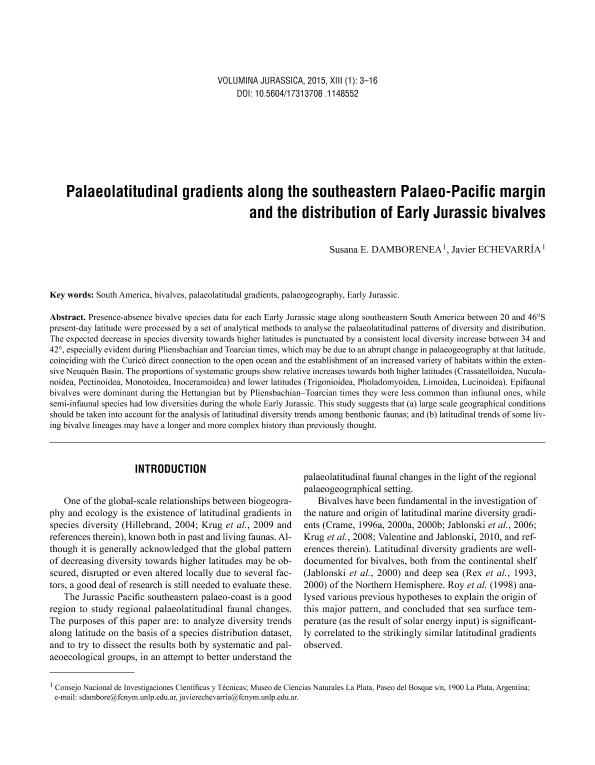Mostrar el registro sencillo del ítem
dc.contributor.author
Damborenea, Susana Ester

dc.contributor.author
Echevarría, Javier

dc.date.available
2021-04-15T15:55:42Z
dc.date.issued
2015-03
dc.identifier.citation
Damborenea, Susana Ester; Echevarría, Javier; Palaeolatitudinal gradients along the southeastern Palaeopacific margin and the distribution of Early Jurassic bivalves; Uniwersytet Warszawski. Państwowy Instytut Badawczy; Volumina Jurassica; 13; 1; 3-2015; 3-16
dc.identifier.issn
1731-3708
dc.identifier.uri
http://hdl.handle.net/11336/130130
dc.description.abstract
Presence-absence bivalve species data for each Early Jurassic stage along southeastern South America between 20 and 46°S present-day latitude were processed by a set of analytical methods to analyse the palaeolatitudinal patterns of diversity and distribution. The expected decrease in species diversity towards higher latitudes is punctuated by a consistent local diversity increase between 34 and 42°, especially evident during Pliensbachian and Toarcian times, which may be due to an abrupt change in palaeogeography at that latitude, coinciding with the Curicó direct connection to the open ocean and the establishment of an increased variety of habitats within the extensive Neuquén Basin. The proportions of systematic groups show relative increases towards both higher latitudes (Crassatelloidea, Nuculanoidea, Pectinoidea, Monotoidea, Inoceramoidea) and lower latitudes (Trigonioidea, Pholadomyoidea, Limoidea, Lucinoidea). Epifaunal bivalves were dominant during the Hettangian but by Pliensbachian-Toarcian times they were less common than infaunal ones, while semi-infaunal species had low diversities during the whole Early Jurassic. This study suggests that (a) large scale geographical conditions should be taken into account for the analysis of latitudinal diversity trends among benthonic faunas; and (b) latitudinal trends of some living bivalve lineages may have a longer and more complex history than previously thought.
dc.format
application/pdf
dc.language.iso
eng
dc.publisher
Uniwersytet Warszawski. Państwowy Instytut Badawczy
dc.rights
info:eu-repo/semantics/openAccess
dc.rights.uri
https://creativecommons.org/licenses/by-nc-sa/2.5/ar/
dc.subject
South America
dc.subject
Bivalves
dc.subject
Palaeolatitudinal gradients
dc.subject
Palaeogeography
dc.subject
Early Jurassic
dc.subject.classification
Paleontología

dc.subject.classification
Ciencias de la Tierra y relacionadas con el Medio Ambiente

dc.subject.classification
CIENCIAS NATURALES Y EXACTAS

dc.title
Palaeolatitudinal gradients along the southeastern Palaeopacific margin and the distribution of Early Jurassic bivalves
dc.type
info:eu-repo/semantics/article
dc.type
info:ar-repo/semantics/artículo
dc.type
info:eu-repo/semantics/publishedVersion
dc.date.updated
2021-04-12T16:24:19Z
dc.journal.volume
13
dc.journal.number
1
dc.journal.pagination
3-16
dc.journal.pais
Polonia

dc.journal.ciudad
Varsovia
dc.description.fil
Fil: Damborenea, Susana Ester. Universidad Nacional de La Plata. Facultad de Ciencias Naturales y Museo. Departamento de Paleontología Invertebrados; Argentina. Consejo Nacional de Investigaciones Científicas y Técnicas. Centro Científico Tecnológico Conicet - La Plata; Argentina
dc.description.fil
Fil: Echevarría, Javier. Universidad Nacional de La Plata. Facultad de Ciencias Naturales y Museo. División Paleozoología Invertebrados; Argentina. Consejo Nacional de Investigaciones Científicas y Técnicas. Centro Científico Tecnológico Conicet - La Plata; Argentina
dc.journal.title
Volumina Jurassica
dc.relation.alternativeid
info:eu-repo/semantics/altIdentifier/url/http://naturalis.fcnym.unlp.edu.ar/repositorio/_documentos/sipcyt/bfa004326.pdf
Archivos asociados
